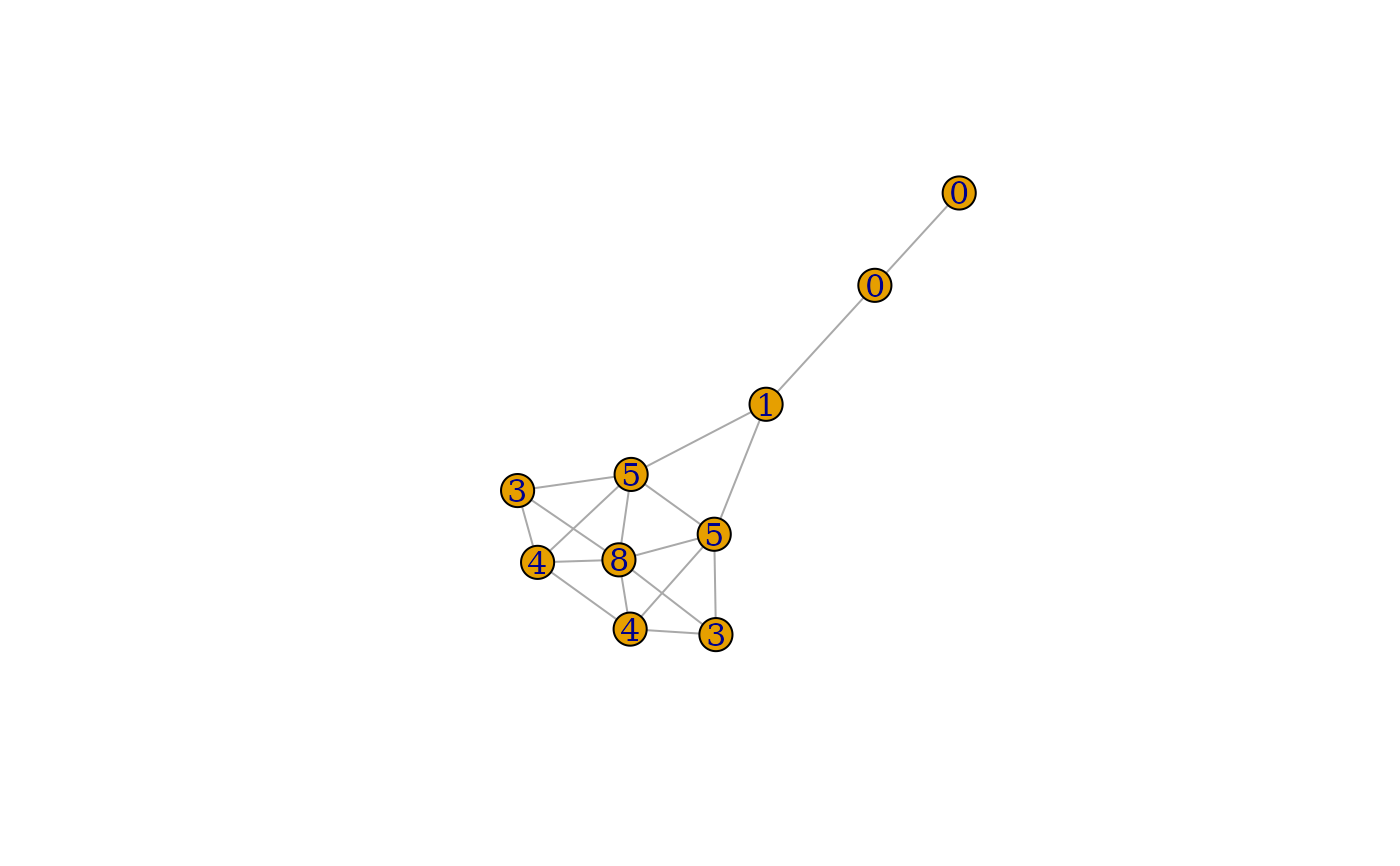Count how many triangles a vertex is part of, in a graph, or just list the triangles of a graph.
Usage
triangles(graph)
count_triangles(graph, vids = V(graph))Value
For triangles() a numeric vector of vertex ids, the first three
vertices belong to the first triangle found, etc.
For count_triangles() a numeric vector, the number of triangles for all
vertices queried.
Details
triangles() lists all triangles of a graph. For efficiency, all
triangles are returned in a single vector. The first three vertices belong
to the first triangle, etc.
count_triangles() counts how many triangles a vertex is part of.
Author
Gabor Csardi csardi.gabor@gmail.com
Examples
## A small graph
kite <- make_graph("Krackhardt_Kite")
plot(kite)
 matrix(triangles(kite), nrow = 3)
#> [,1] [,2] [,3] [,4] [,5] [,6] [,7] [,8] [,9] [,10] [,11]
#> [1,] 4 4 4 4 4 4 4 4 6 6 7
#> [2,] 1 1 2 6 6 6 7 7 1 7 2
#> [3,] 2 3 5 1 3 7 2 5 3 8 5
## Adjacenct triangles
atri <- count_triangles(kite)
plot(kite, vertex.label = atri)
matrix(triangles(kite), nrow = 3)
#> [,1] [,2] [,3] [,4] [,5] [,6] [,7] [,8] [,9] [,10] [,11]
#> [1,] 4 4 4 4 4 4 4 4 6 6 7
#> [2,] 1 1 2 6 6 6 7 7 1 7 2
#> [3,] 2 3 5 1 3 7 2 5 3 8 5
## Adjacenct triangles
atri <- count_triangles(kite)
plot(kite, vertex.label = atri)
 ## Always true
sum(count_triangles(kite)) == length(triangles(kite))
#> [1] TRUE
## Should match, local transitivity is the
## number of adjacent triangles divided by the number
## of adjacency triples
transitivity(kite, type = "local")
#> [1] 0.6666667 0.6666667 1.0000000 0.5333333 1.0000000 0.5000000 0.5000000
#> [8] 0.3333333 0.0000000 NaN
count_triangles(kite) / (degree(kite) * (degree(kite) - 1) / 2)
#> [1] 0.6666667 0.6666667 1.0000000 0.5333333 1.0000000 0.5000000 0.5000000
#> [8] 0.3333333 0.0000000 NaN
## Always true
sum(count_triangles(kite)) == length(triangles(kite))
#> [1] TRUE
## Should match, local transitivity is the
## number of adjacent triangles divided by the number
## of adjacency triples
transitivity(kite, type = "local")
#> [1] 0.6666667 0.6666667 1.0000000 0.5333333 1.0000000 0.5000000 0.5000000
#> [8] 0.3333333 0.0000000 NaN
count_triangles(kite) / (degree(kite) * (degree(kite) - 1) / 2)
#> [1] 0.6666667 0.6666667 1.0000000 0.5333333 1.0000000 0.5000000 0.5000000
#> [8] 0.3333333 0.0000000 NaN
